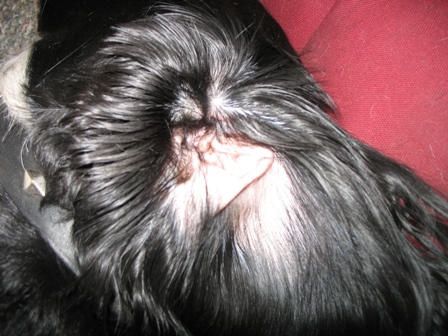|
Ear
Problems in Pets
And the Solutions
 Ear infections and problems are some of the top reported
problems faced by many pet owners. Does your dog or cat shake their head and scratch their ears or rub their
ears against the ground or furniture? Do you ever notice a foul smelling, discharge in their ears, black,
yellowish or brown in color? Are their ears red and tender? These are all signs of an ear infection or problem
in your pets. Ear infections and problems are some of the top reported
problems faced by many pet owners. Does your dog or cat shake their head and scratch their ears or rub their
ears against the ground or furniture? Do you ever notice a foul smelling, discharge in their ears, black,
yellowish or brown in color? Are their ears red and tender? These are all signs of an ear infection or problem
in your pets.
A dog or car's ear canal is L-shaped which causes dirt, moisture, parasites; mites, and wax to be trapped in the
canal which can lead to ear infections. Dog which have long, floppy ears tend to be more prone to ear problems due
to the lack of air circulation available to the canal. With long haired, floppy eared dogs, you can keep the hair
trimmed on the inside of the ear to increase air circulation.
The conventional treatment for most infections is antibiotic and anti-fungal medications. The problem with these
treatments is that they treat only the symptoms, not the underlying cause. To successfully conquer the problem,
both must be treated. Medications will mask the problem and may actually make it worse in the long-run by creating
a chemical imbalance in the ear resulting in long-term problems.
Approximately 80% of ear infections are actually caused by allergies, with the ear infections and problems actually
being one of the symptoms. You need to treat the allergy; the underlying cause as well as the ear infection for a
long-term cure.
Treatment
One of the first things you need to do is to clean your pet's ears. Use white vinegar
(acetic acid) diluted by half with water and squirt this into the affected ear with a small squirt bottle or
syringe. Rub the base of the ear to move it into the canal and clean the outer ear with cotton balls or a soft
cloth. The vinegar will remove debris from the ears as well as kill the yeast and bacteria responsible for ear
infections. Do this for 5-7 days then continue weekly to avoid recurring problems.
You can also treat the infection herbally. Garlic, sage and thyme all have natural antibiotic and anti-fungal
properties. Pau d’arco has natural antibiotic properties. Soak the herb of choice in calendula oil overnight,
remove it and using a dropper, apply the oil to the infected ear, 2-3 drops a day for several days. You should see
a cessation in the infection. This should also eliminate ear mites.
For the itching and inflammation you can apply aloe or calendula essential oils topically to the ear twice a day.
Vitamin C can also be added to your pet's diet and works in two ways; it suppresses the product released from cells
in the body that causes itching (histamine) and it will help the adrenal glands, which produces a natural steroid
that can help reduce inflammation, to function more efficiently. Watch the dosage, vitamin C can cause diarrhea.
Starting with a low dosage of 100mg per 10lb of body weight should be a safe dosage. If there are problem, decrease
the dosage.
The next and very important step in treatment is working on the underlying cause, most likely allergies. Some of
the main food allergies are grains, such as corn and wheat in many commercial pet foods as well as some of the
protein sources and in some more sensitive dogs and cats, the additives and preservatives can cause problems as
well.
The best thing you can do for your pet is do change their diet over to a natural, homemade diet free of the toxins
of commercial pet foods. You may have to try different foods to figure out what your pet will respond to best, but
in the long run it is worth it for your pet's health and comfort. There are some natural and organic alternatives
out there but you need to take the time to know what is really in the food you are feeding your pets.
There are also some supplements you can add to the diet to help with allergies. Quercetin has been effective for
people with allergies and may be effective in dogs, it helps prevent an allergic response in the gastrointestinal
tract, making food allergies less of a problem. The dose is 25mg per 10 lbs of body weight daily, and omega-3 fatty
acid, a must for any allergy that triggers recurring ear infections. My preference for omega-3 is organic flaxseed
oil or cold salmon oil. Aside from the allergy benefits, omega-3s offer many benefits to pets including improving
the skin and coat and for joint and heart problems to name just a few.
Vet Time
As much as I am a strong advocate for natural health and treating your pet at home when the options are advisable,
there are times when you must turn to a professional for treatment.
Most of the time, especially when caught and treated early, ear problems are confined to the outer ear and can be
successfully treated at home. When the infection is in the inner-ear or cannot be alleviated by the above
treatment, you need to see a vet. Symptoms to be watchful for include; head tilting, clumsiness, walking in circles
or drooping eyes. The vet may need to drain fluids and treat with antibiotics if the infection has progressed to
this point. Sometimes even more aggressive measures need to be taken. In any case where surgery is advised, I
always suggest getting a second opinion. Not every vet knows everything.
Something else to be watchful for is that aggressive scratching and head shaking can cause a hematoma in the ear.
Hematomas can cause permanent damage if severe enough and left untreated. A vet must evaluate and advise proper
treatment.
The best thing you can do for your pet is to take the time to spend time with them and notice any problems before
they turn into major problems. Many pet health issues can be treated at home with the right knowledge and if caught
early enough.
by Deanna Raeke
Back to
Top
###
| 






 Ear infections and problems are some of the top reported
problems faced by many pet owners. Does your dog or cat shake their head and scratch their ears or rub their
ears against the ground or furniture? Do you ever notice a foul smelling, discharge in their ears, black,
yellowish or brown in color? Are their ears red and tender? These are all signs of an ear infection or problem
in your pets.
Ear infections and problems are some of the top reported
problems faced by many pet owners. Does your dog or cat shake their head and scratch their ears or rub their
ears against the ground or furniture? Do you ever notice a foul smelling, discharge in their ears, black,
yellowish or brown in color? Are their ears red and tender? These are all signs of an ear infection or problem
in your pets.